Vol 3 No. 43 TROPIC LIGHTNING NEWS October 21, 1968
Index
| Unit Page | Unit Page | Unit Page | Unit Page |
| 1/5 1 | 2/12 7 | 2/77 Arty Photo 2 | 3/22 Photo 6 |
| 1/5 Photo 1 | 2/12 Photos 7 | 3rd Bde Photo 8 | 3/22 6 |
| 1/5 8 | 2/12 Photo 8 | 3/4 Cav 4 | 3/22 6 |
| 1/27 3 | 2/27 Photo 3 | 3/4 Cav Photos 4 | 588th Engr 3 |
| 1/27 3 | 2/27 Photo 6 | 3/22 3 | GI Slang 1 |
| 1/27 Photo 6 |
GI’s Unique Vocabulary - What Did He Say?
CU CHI - The American soldier has always developed his own
vocabulary to describe the sights and sounds of war, and the soldiers of today
are maintaining that tradition. The jargon of the Vietnam GI is often
humorous, sometimes confusing.
From the moment a replacement enters Vietnam he is subjected to the
lingo of war. The new man is a “turtle” for the man he replaces
because he seems to be so slow in arriving.
If he did not know before coming across the “big pond” (Pacific
Ocean), he soon learns that MACV stands for Military Assistance Command,
Vietnam; USARV means United States Army, Vietnam; and “short-timer” is a
soldier going home soon.
A few of the terms for his fighting comrades, “jet jockey” and
“Saigon warrior”, are self evident. Many are not.
It is possible to spend an entire tour of duty in Vietnam without
learning all the terms for an infantryman. He is a “grunt” or a
“stump jumper”. He is called a “gravel crusher” or, most often, a
“leg.”
After a few months in the “boondocks” the GI respects the
courage of his tenacious foe and calls him “Mister Charles” or “Sir
Charles.”
Enemy infested jungles become the “VC National Forests.”
A wounded soldier is “zapped” by Charlie and enemy soldiers are
“greased,” “massaged,” or “blown away,” by “friendlies” (Allied
soldiers).
Abbreviations
Abbreviations are used extensively in this war and it is possible
to carry on a conversation that would leave a linguist dizzy.
The military units of Vietnam are divided into several categories.
The “good-guys” are:
ARVN - Army of the Republic of Vietnam. This group is the
Vietnamese regular army.
CIDG - Civilian Irregular Defense Group. A Vietnamese force
that maintains territorial border surveillance.
PF - Popular Forces. This force, recruited at local levels
and kept in their home villages, is concerned with civil defense.
RF - Regional Forces. These troops maintain public order and
security in rural areas.
The Enemy
Opposing the “good-guys” are members of the:
NVA - North Vietnamese Army. Trained and well equipped
soldiers, the NVA have taken over much of the fighting.
NLF - The National Liberation Front is the political organization
of the Communist forces.
VC - Viet Cong. This term, dating back to the French
Indochina War, refers to the local guerillas.
Vietnam Slang
From the Vietnamese language the GI’s have adopted
“chop-chop” for food, the French word “beaucoup” for many, and “xin
loi” for the phrase “sorry ‘bout that.”
A snake is called “Mr. No-shoulders” and if a rumor going
around Da Nang can be believed the term “Sabre Jet” is fitting for the
Vietnam mosquito.
Army and Air Force pilots have their own lingo for the various
aircraft employed in Vietnam.
The A-1E Skyraider, a prop driven World War II
fighter-bomber, is affectionately labeled “Spad.”
The briefing room language of attack pilots that fly over the north
include:
SAM - surface to air missile used by North Vietnamese against
American aircraft.
Jinx - means to take evasive zig-zag action to avoid SAM’s.
Junk - what becomes of a million dollar war plane that zagged when
it should have zigged.
Beginning the day a “turtle” arrives, and until he leaves
Vietnam as a “short-timer,” the most important term in a GI’s vocabulary
encompasses everything from his sweetheart to Mom’s apple pie and a soft bed:
The United States - reverently called “The World.”
NVA Attack Night Defenses
Fail To Score Three Times
By SP4 Richard Patterson
DAU TIENG - Heavy ground attacks on a night defensive position of
the 25th Infantry Division’s 1st Battalion (Mechanized), 5th Infantry, left
128 enemy soldiers dead in a five-day period.
The enemy, losing 99 men in an earlier attack, made a concerted
assault on the night laager of Company A shortly after midnight.
A listening post reported that there were many noises all around
them and almost simultaneously two trip flares went off along the wood line.
The Bobcats opened fire with track-mounted .50 caliber machine guns
from their position two miles southwest of Dau Tieng, compelling the NVA force
to attack before they were completely prepared.
During the 3 ½ -hour battle, the enemy made a determined effort to
penetrate the defensive wire in front of the “one-one” track. The
track was protected by an anti-RPG screen, and the crew slugged it out with two
NVA rocket teams.
Specialist 4 Dennis MarcAurele, of Waterbury, Conn., admitted,
“It was touch and go there for a while. One of Charlie’s RPG teams was
about 60 meters away and I could see them firing at me. A couple of times
I thought I’d had it.”
MarcAurele was firing the .50 caliber machine gun when an RPG round
went over the cyclone fence and exploded next to the commander’s cupola.
The blast knocked him down inside the track, but he climbed back up and
continued firing.
Another RPG nicked the back corner of the track and started a fire.
MarcAurele abandoned the track but the fire went out almost immediately so he
climbed back in and kept up the fire.
A sweep of the battlefield the next morning turned up 42 bodies of
North Vietnamese, seven RPG launchers with 55 rounds and 12 boosters, 12
individual weapons and several bangalore torpedoes.
Later in the same day Alpha Company was replaced by Company B at
the position, and a bulldozer reinforced the perimeter with earthen berms.
That night the enemy attacked again. This time, beginning at 3:00 a.m.,
the NVA launched a well-coordinated attack under cover of an intense mortar,
107mm rocket, and RPG bombardment.
(Continued on Back Page)
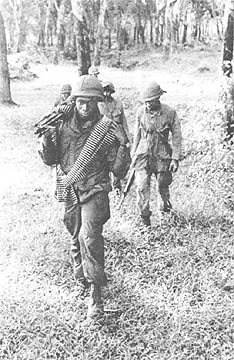 |
MACHINE GUNNER - Private First Class Isaac Gary of Europa, Miss., moves out with Infantrymen of Company A, 1st Battalion (Mechanized), 5th Infantry. They were sweeping the battlefield for bodies and weapons after a night of heavy fighting around their night laager position. (PHOTO BY SP4 RICHARD PATTERSON) |
Page 2 TROPIC LIGHTNING NEWS October 21, 1968
Decorated
| BRONZE STAR MEDAL (HEROISM) | |
|
LTC Thomas C. Nunn, HHC, 2d Bn, 14th Inf CPT Robert A. Snyder, B Btry, 11th Arty CPT George D. Featherston, Co B, 3d Bn, 22d Inf CPT Harry K. Jowers, C Btry, 7th Bn, 11th Arty 1LT David C. Kregar, B Btry, 7th Bn, 11th Arty 1LT Richard Booth, HHC, 3d Bn, 22d Inf 1LT David Beach, HHC, 4th Bn, 23d Inf 1LT Barry Buckley, Co B, 3d Bn, 22d Inf 1SG Ronald G. Combs, B Btry, 7th En, 11th Arty SFC Carlos Solivan, B Btry, 7th Bn, 11th Arty SFC George C. Kearns, B Btry, 7th Bn, 11th-Arty SFC Ralph Walters, C Btry, 7th Bn, 11th Arty SFC Paul Gargis, HHC, 3d Bn, 23d Inf SFC James Smith, A Trp, 3d Sqd, 4th Cav PSG Gordon Burns, Co B, 3d Bn, 22d Inf PSG Walter H. Langley, HHC, 4th Bn, 23d Inf PSG Marion D. Wright, HHC, 4th Bn, 23d Inf PSG John Ellison, Co B, 3d Bn, 22d Inf SSG George Dukes, Co B, 2d Bn, 22d Inf SSG Colon Gore, Co A, 1st Bn, 5th Inf SSG Bernard T. Hayward, B Btry, 7th Bn, 11th Arty SP6 Edvent Grinnell, HHC, 2d Bn, 22d Inf SGT Frederick Watts, B Btry, 7th Bn, 11th Arty SGT Richard Peeler, C Btry, 7th Bn, 11th Arty SGT Kenneth R. Bailey, B Btry, 7th Bn, 11th Arty SGT Leo Fox, C Btry, 7th Bn, 11th Arty SGT William E. Glass, B Btry, 7th Bn, 11th Arty SGT Daniel E. Lewis, B Btry, 7th Bn, 11th Arty SGT Eugene Anhalt, C Btry, 7th Bn, 11th Arty SP5 Michael M. McCaughtry, B Btry, 7th Bn, 11th Arty SP5 Edward Young, C Btry, 7th Bn, 11th Arty SP5 Daniel O. Pina, B Btry, 7th Bn, 11th Arty |
CPL Danny Durgam C Btry, 7th Bn, 11th Arty CPL Jerome Vice, C Btry, 7th Bn, 11th Arty CPL William F. Robicheau, B Btry, 7th Bn, 11th Arty SP4 Vincent P. Dimarzo, Co B, 2d Bn, 12th Inf SP4 George W. Jones, B Btry, 7th Bn, 11th Arty SP4 Robert A. McMann, Co A, 2d Bn, 22d Inf SP4 Turner R. Smith, Co D, 65th Engr Bn SP4 Anthony N. James, B Btry, 7th Bn, 11th Arty SP4 Thomas G. Hagland, Co D, 65th Engr Bn SP4 Terrence P. Clark, Co B, 2d Bn, 22d Inf SP4 Albert W. Hawkins, Co D, 3d Bn, 22d Inf SP4 Richard L. Ebergart, B Btry, 7th Bn, 11th Arty SP4 Dennis R. Thomas, B Btry, 7th Bn, 11th Arty SP4 Phillip Latta, Co A, 1st En, 5th Inf SP4 Gerald H. Krell, B Btry, 7th Bn, 11th Arty SP4 Pedro T. Gamez, B Btry, 7th Bn, 11th Arty SP4 Dennis R. Thomas, B Btry, 7th Bn, 11th Arty SP4 William Glass, B Btry, 7th Bn, 11th Arty SP4 Able A. Garcia, B Btry, 7th En, 11th Arty PFC Douglas Syberston, HHC, 3d Bn, 22d Inf PFC Angelo Viteritti, Co A, 2d Bn, 22d Inf PFC Jimmy D. Lester, Co A, 2d Bn, 27th Inf PFC John Roberts, Co B, 3d Bn, 22d Inf PFC John F. Kirkpatrick, Co A, 2d Bn, 22d Inf PFC Isaac K. Gary, Co A, 1st Bn, 5th Inf PFC David Stairs, C Btry, 7th Bn, 11th Arty PFC Allen Ray, B Btry, 7th Bn, 11th Arty PFC Michael B. Smith, Co A, 2d Bn, 22d Inf PFC Tommy B. McKamey, Co B, 3d Bn, 22d Inf PFC Claudie S. McCrory, Co A, 2d Bn, 22d Inf PFC Kenneth Gjonola, C Biry, 7th Bn, 11th Arty |
Better Mail In Your FPCA
Your Time Is Almost Up
You have just about run out of time if you haven’t already made
sure you are properly registered to vote in your home state and requested your
absentee ballot for the coming election.
The fact that you can’t - or don’t - vote this year may not
matter much to you. There are a lot of people in this category - they just
can’t see any reason to get too excited about making little X’s on a piece
of paper or pulling the handles in a voting booth.
This is unfortunate because they are, by their lack of interest and
action, helping to undermine and destroy our democratic society and processes.
It’s a recognized fact that the United States is, economically
and militarily, the most powerful nation in the world. It is almost
inconceivable that we could be defeated in a military confrontation or through
the breakdown of our economic system.
Yet it is possible that our democracy as we know it could shatter
and crumble from within because of a disinterested, complacent and
non-participating citizenry.
It makes little difference which candidate or party you support.
It is, however, vitally important that you exercise your right as a citizen and
cast your ballot.
Wihtout the continuing interest and participation of every citizen
in the political processes and activities of government, our democracy may cease
to exist.
The dreams and sacrifices of millions in the past and the hope of
future generations are embodied in the right of every citizen to vote.
Don’t fail to cast your ballot. (AFPS)
Help Control Heat Injury, It’s A Must
All commanders are reminded of their responsibilities for the
prevention of heat injuries. Normally, heat exhaustion is preventable.
Closely observe and reduce, when possible, continuous arduous work
of personnel newly arrived in country. The normal period for
acclimatization is one to two weeks.
Provide adequate amounts of water or other fluids and supplemental
salt to personnel in each unit.
When the situation permits, arrange for periodic rest periods,
especially for personnel that are not acclimatized.
Designate 6th & 7th Campaigns
The Department of the Army has designated two more Vietnam
campaigns.
The sixth campaign, from Jan. 30, 1968, through April 1, 1968, will
be called “Tet Counteroffensive.”
A seventh campaign has been designated beginning April 2, 1968.
Its name and termination date will be announced later.
Battle stars for these periods are authorized for wear on the
Vietnam Service Ribbon in accordance with Army Regulation 672-5-1. (ANF)
Tropic Lightning
Combat Honor Roll
 The name of Sergeant Daniel R. Doyle, US50203036, assigned to
Battery B, 2d Battalion, 77th Artillery, is added to the Tropic Lightning Combat
Honor Roll this week.
The name of Sergeant Daniel R. Doyle, US50203036, assigned to
Battery B, 2d Battalion, 77th Artillery, is added to the Tropic Lightning Combat
Honor Roll this week.
Sergeant Doyle distinguished himself by heroic actions on 6 May,
1968, during an attack on a fire support base in the Republic of Vietnam.
While approaching a suspected enemy village, Company A came under
an intense hostile attack. The order was immediately given to assault the
enemy fortifications. As he moved forward, Sergeant Doyle spotted a
hostile soldier hidden in the brush. Reacting instantly, he killed the
enemy soldier.
As he continued to advance, Sergeant Doyle came under devastating
hostile fire from a well-concealed bunker. With complete disregard for his
own safety, he crawled through a heavy volume of fire until he could see the
enemy rifle muzzles protruding from the bunker’s firing ports.
Receiving covering fire from his comrades, Sergeant Doyle rushed
the hostile fortification and tossed a grenade inside. No sooner had he taken
cover when the insurgents threw the grenade out.
Determined not to suffer defeat, Sergeant Doyle pulled the pins out
of two grenades. He then triggered the firing pins, held the grenades a
few seconds, and tossed them into the bunker, killing the hostile occupants.
His valorous actions contributed immeasurably to the defeat of the enemy force.
Sergeant Doyle’s personal bravery, aggressiveness and devotion to
duty are in keeping with the highest traditions of the military service and
reflect great credit upon himself, his unit, the 25th Infantry Division and the
United States Army.
The TROPIC LIGHTNING NEWS is an authorized publication of the 25th
Infantry Division. It is published weekly for all division units in the Republic of
Vietnam by the Information Office, 25th Infantry Division, APO San Francisco
96225. Army News Features, Army Photo Features, Armed Forces Press Service and Armed
Forces News Bureau material are used. Views and opinions expressed are not necessarily
those of the Department of the Army. Printed in Tokyo, Japan, by Pacific Stars and
Stripes.
MG Ellis W. Williamson . . . . Commanding General
MAJ Andrew J. Sullivan . . . Information Officer
2LT Don A. Eriksson . . . . . . Officer-in-Charge
SP4 Bill Berger . . . . . . . . . . . Production Supervisor
SP4 Stephen Lochen . . . . . . Editor
SP4 Tom Quinn . . . . . . . . . . . Asst. Editor
Page 3 TROPIC LIGHTNING NEWS October 21, 1968
Velvet And Licorice An Odd Combination
DAU TIENG - When First Lieutenant James Carper thinks of his family
back in Tampa, Fla., his thoughts may include two members who slither.
“Their names are Velvet and Licorice - although one eats dog
food, the other still prefers mice,” said Carper, the artillery liaison for a
battalion of the 3d Brigade.
Carper and his wife Gloria have kept at least two giant black
indigo snakes around their home for the past few years.
“Velvet is a slim, trim six-footer and Licorice measures in at a
shapely 5 feet, 10 inches,” he said.
The serpentine duo have been parents many times over. In
fact, Velvet is expecting again, related Carper.
“Perhaps when I return home in a few months we’ll have all
kinds of little snakes running about. That will make it an even more
interesting homecoming.”
His wife has taken the snakes on the banquet circuit many times,
traveling from one civic group to another.
“Now that Velvet is expecting again their public appearances will
be curtailed for awhile. You just can’t get Licorice to leave the house
without Velvet, and she’s in no condition to be going anyplace,” observed
Carper.
Although her measurements are almost 7 by 7 by 7, Velvet is one of
the number one pinups of 3d Battalion, 22d Infantry troopers.
“In fact, the battalion considers our two snakes absentee
mascots,” noted Carper. “It’s a great feeling when members of your
family make good.”
| HELPING HAND - Specialist 4 Bennie I. Langston, a squad leader with Company A, 2d Battalion, 27th Infantry Wolfhounds finds out that a combat photographer is not only good for a few pictures, but also a helping hand and sometimes both. Langston, from Sillbee, Tex., was on a reconnaissance-in-force operation northwest of Saigon when he took the helping hand of the lensman. (PHOTO BY SP4 BILL CLEVENGER) |  |
Wolfhounds Ambush VC In Triangle
CU CHI - Soldiers from Company C, 1st Battalion, 27th Infantry
Wolfhounds working near the Iron Triangle sprung a night ambush killing four
enemy soldiers.
The company’s 3d Platoon, led by Staff Sergeant John R. Hinton,
28, Jacksonville, Tex., received the order to set up an ambush 400 meters from
the battalion’s perimeter.
The platoon had set up and after a few hours heard strange noises.
The troops waited until the noises became louder and more distinct. Soon
they saw a large NVA patrol heading towards them.
When the enemy was close enough to the ambush, the Wolfhounds
opened up with claymore mines, small arms and machine gun fire. Once the
firing had ceased the platoon returned to the night location.
The following morning the area was searched and four bodies were
found. The 2d Brigade troopers also captured three AK-47 rifles, several hand
grenades, ammunition and one CHICOM pistol belonging to an NVA officer killed in
the ambush.
Uproots Tree And Occupant
DAU TIENG - To engineers driving Rome plows, the job is, for the
most part, routine, but not for Specialist 5 Richard Strubberg, of St. Louis,
Mo.
Working with the 588th Engineer Battalion from Dau Tieng, Strubberg
was driving a Rome plow, cutting down rubber trees near a village in the Ben Cui
Rubber Plantation. He was clearing a night location for the 1st Battalion
(Mechanized), 5th Infantry Bobcats near the site where human wave and mortar
attacks had occurred four times in the last 10 days. The Bobcats had
killed more than 200 enemy.
“We had been cutting down rubber trees there the day before,”
stated Strubberg, “and we had left a row of trees standing near the
villagers’ garden.
We planned to cut the rest and then cut down that last row without
damaging the villager’s crops. I started plowing down the row, when I
pushed over one big tree and it came out of the ground, roots and all.
Then I saw a hole underneath the tree.
“I raised up in my seat and saw it was a well-made bunker and
noticed a leg sticking up.
“I grabbed my rifle, hopped off the plow and went over to the
bunker to check it out. I thought it was a dead VC,” he went on, “and
then all of a sudden it moved!
“I just about jumped out of my skin. I called Lieutenant
Hamlin, my platoon leader, who called out a security team, the recon platoon of
the battalion, and in the meantime I started digging him out.
“I had caved in the bunker, almost suffocating him. When I
got him out I waved my shirt over him to give him air. He was wounded in
the hand, arm and head, but was well bandaged. He was real young and
dressed in an NVA uniform.”
A dust-off was called and they took him to Tay Ninh.
First Lieutenant Ward Hamlin of South Haven, Mich., stated, “The
5th Mech killed 37 VC and NVA here last night when they hit our night laager
position. No doubt he was one of the wounded.
“He probably saw that remaining row of trees and figured we
wouldn’t cut it down, but we surprised him.”
Strubberg summed up his feelings: “You just never know what
you’re going to dig up in Vietnam. I’ll sure keep my eyes peeled from
now on!”
Uncover Center
CU CHI - While searching the dense jungles of the Iron Triangle,
northwest of Saigon, 2d Brigade soldiers from the 1st Battalion, 27th Infantry
Wolfhounds uncovered an enemy rest and recuperation center.
The Tropic Lightning soldiers, sweeping an area hit by airstrikes,
discovered a bunker complex containing sleeping quarters, tables, chairs, and
cabinets.
Some 15 pounds of medical supplies and documents were also
uncovered. The documents indicated that the area was used by wounded
soldiers for recuperation and as a type of rest center for the enemy troops.
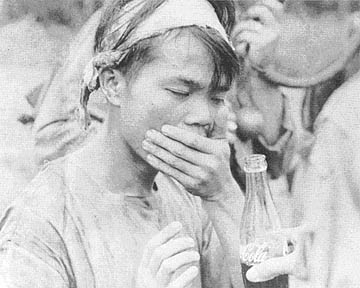 |
HAVE A COKE - An NVA soldier who accepted the South Vietnamese government’s offer of amnesty under the Chieu Hoi (Open Arms) program, is offered a coke to ease his coughing spells. The North Vietnamese soldier came out of hiding and turned himself in to a 1st Brigade unit sweeping Highway 26 near Dau Tieng. (PHOTO BY SP4 DON BROWN) |
Page 4-5 TROPIC LIGHTNING NEWS October 21, 1968
3/4 Cavalry
When You Hear Thunder On The MSR
CU CHI - The last orange streaks of an October sunset are fading
from the sky, and distant clouds and a quickening breeze, heavy with moisture,
forecast a coming storm.
The commander of the lead tank waits and watches from atop his
cupola, a cigarette cupped in his hand, the other arm draped over the .50
caliber in front of him. He gazes down the stretch of road that will be
his to patrol tonight, and his thoughts are entirely his own.
Over the radio the troop commander is telling someone to get his
tail in gear and his track in line. A laconic “roger” replies.
Then silence.
It is deceptively peaceful and no one seems to feel the need to
raise his voice or speak more than a few words at one time. An occasional laugh,
the clatter of a belt of ammunition being loaded into a machine gun, the scrape
and rustle of legs trying to find comfortable positions are the only sounds
which break the quiet.
The thrust of 90mm gun barrels puncture the last pale yellow-gray
light over the horizon, and the steel giants squat in line, waiting. . . .
“All right, move it out!”
One by one, the engines of seven APCs and three tanks turn over,
catch and burst into roaring, throbbing life - the blasts from their exhausts so
hot that it is impossible to stand behind them. Lurching and clawing at
the mud, the tracks move into convoy formation and the tanks take up front and
rear security positions.
All is sound and movement, bigger than life, power carrying you
along in its swell. Down the road, Indian file, they grind along in the
night. The search light of the lead tank stabs at the darkness and like
the slash of a sword blade in slow motion, slices through the tree line that
rises beyond the rice paddies which border the road. A good place for an
ambush, all right. Someone yanks back on the handle of a .50 caliber.
Everyone knows they’re there.
And then the high, sharp, staccato crack of an AK-47, higher than
M-16’s, splits the night, and red tracers streak past. Suddenly, the
whole column opens up with everything it’s got.
This is the Three-Quarter Cav.
Every day, somewhere along the main supply routes from the Phu
Cuong bridge on the Saigon river, or from Tan Son Nhut Air Base through Cu Chi
and on up to Tay Ninh, an element of the 3d Squadron, 4th Cavalry is engaged in
securing the road for the convoys which supply the Tropic Lightning Division.
At other times the Cav may be supporting the infantry on offensive operations or
providing security for artillery fire support bases in the Cu Chi and Tay Ninh
areas.
At night, when the Viet Cong like to mount their attacks, the Cav
often works with local Vietnamese Regional and Popular Forces to cordon off
villages and safeguard them against enemy terrorism.
The Cav’s role is a diversified one.
Delta Troop’s observation helicopters conduct reconnaissance
missions over suspected enemy positions. Aerial scout teams supply the
visual information needed by infantry and armored units conducting ground
operations. And teams made up of Cobras and Huey gunships provide
tremendous fire power in support of ground forces.
Massive and flexible fire power characterize the Three-Quarter Cav.
The “Horsemen” guarantee that vital supplies flow smoothly along the MSR and
stand ready to provide air and ground striking forces against the enemy.
|
Story And Photos By PFC Robinson Truitt |
 |
AERIAL RECON - Looking for signs of Viet Cong encampments and bunkers, an OH-6A Cayuse sweeps up behind a 3/4 Cavalry trooper. |
| READY FOR CHARLIE - Specialist 5 Vincent R. Kelly of Corpus Christi, Tex., commander of a Bravo Troop tank, loads a 90mm round into the breach of his main gun. | 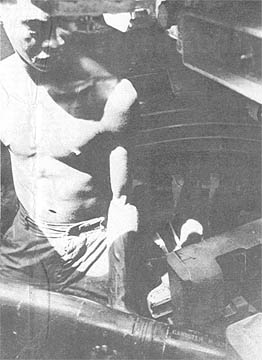 |
 |
GUARDIANS OF THE SUPPLY ROUTE - A 3/4 Cavalry tank and armored personnel carrier convoy await the signal to move out. |
| FLYING FIRE POWER - An AH-1G, the first attack helicopter in the Army arsenal, sports the shark-toothed insignia of the 3/4 Cavalry’s Delta Troop. | 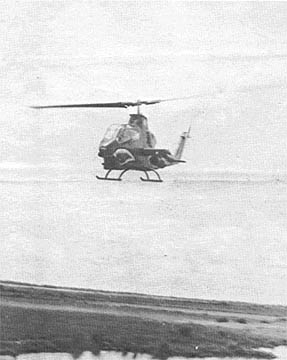 |
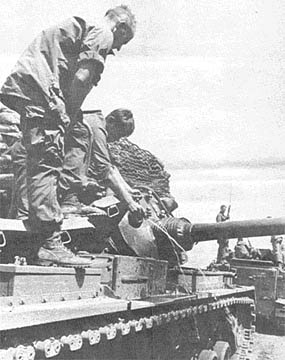 |
GETTING READY TO MOVE - Sergeant First Class Bobby Hollis of Columbia, Tenn. and Specialist 4 Mitchell J. Tipton of Olivehurst, Calif., bleed the fuel filters of their tank. |
| IN TIP-TOP SHAPE - The FM radio mount on a UH-1C Huey helicopter is replaced by Specialist 5 Dean W. Rhoades of Sacramento, Calif. | 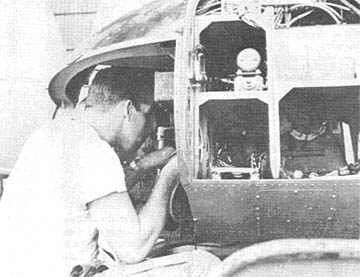 |
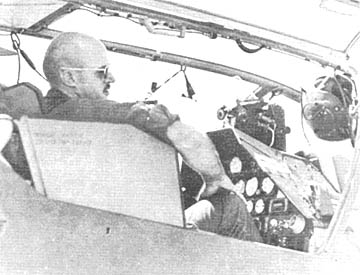 |
MISSION COMPLETE - Captain Garrett Marcinkowski of Stamford, Conn., operations officer of Delta Troop, sits at the controls of his Cobra after completing a convoy escort mission near Tay Ninh. |
|
ALERT TO SIGNS OF ENEMY ACTIVITY - Sergeant First Class Bobby Hollis watches behind a .50 caliber machine gun atop a 3/4 Cavalry tank cupola as he escorts a supply convoy through a village on the main supply route to Tay Ninh.
|
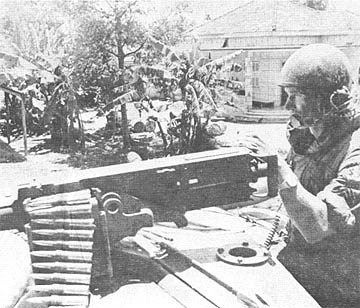 |
Page 6 TROPIC LIGHTNING NEWS October 21, 1968
Army Beats All In Shoot-Outs
Led by six Army marksmen, the United States shooting team won every
individual and team match in the recent international military sports
championships at Fontainbleau, France.
In competition against marksmen from 13 nations, the Americans
dominated pistol and rifle events and, in addition, won all three special
Olympic-style shooting contests.
Army participants, members of the Marksmanship Training Unit at
Fort Benning, placed among the top three in every individual event. (ANF)
 |
A WHAT? - First Lieutenant James W. Carper of Tampa, Florida, finds it hard to believe that the VC suspect is going to be lifted off along with his motorcycle. Alpha Company, 3d Battalion, 22d Infantry detained the suspect while on a sweep along a highway west of Nui Ba Den mountain. (PHOTO BY SP4 HERB BURDETT) |
| HAPPINESS IS A WARM PUPPY – ‘Heavy but happy load’ seems to be the thoughts of Specialist 4 Steve Billimeier of Sacramento, California, as he prepares to board a chopper. The dog, named Killer, is the mascot for the commo section of Headquarters and Headquarters Company, 1st Battalion, 27th Infantry Wolfhounds. (PHOTO BY SP4 HECTOR NADAL) |  |
Nhi Binnh Village Gets Gift
From A Lions Club In Florida
TAN SON NHUT - The village of Nhi
Binnh, known to most infantrymen
simply as Catholic Village has been the scene of numerous fierce military
operations in and about its boundaries.
But Regulars of the 3d Battalion, 22d Infantry also have spent
countless hours helping the occupants of this quaint little village only a few
miles north of Saigon. Recently their help took the form of a 22-pound
bundle sent to the village by Mr. and Mrs. C. Ward Carper and other members of
the West Hillsborough Lions Club in Tampa, Fla.
The Carper’s son, James, is the artillery liaison officer with
the battalion. “We were operating in and around the village a few months
ago and I discovered through one of our interpreters, Staff Sergeant Vinh, that
there were certain things the villagers needed but couldn’t get,” said
Carper.
“In some cases they couldn’t afford these items because the VC
had been taxing them for many months, or the VC in the area kept them from
traveling to Saigon to do their shopping,” continued Carper. “In
effect the VC had put a partial economic blockade around the Village.”
Sergeant Vinh conveyed the needs of the villagers to First
Lieutenant Carper and he in turn informed his parents. The bundle recently
arrived and included 25 spools of thread, 17 packages of needles, 10 pieces of
yard goods, each four yards long, 10 pairs of rubber sandals, 24 rubber balls,
three dolls, three shirts and one blouse, three nurses uniforms and a stuffed
dog!
These common every day items were just what the villagers said they
needed, according to Carper. “I hope to return there someday to see
first hand the results of the generosity of the West Hillsborough Lions Club”
he added.
Listening Post-Early Warning System
CU CHI - One of the many jobs an infantryman pulls in the field is
that of taking his turn on a listening post or LP.
Great stories rarely result from listening post duty, but the LP is
one of the primary defenses of any unit spending a night in the field.
The quick thinking of the men manning a listening post can alert
the remainder of the unit to an impending attack. Often, men on an LP see
the enemy at close range sometimes less than fifteen meters away.
“The mission of the listening post is to provide the unit with an
early warning system,” said Sergeant First Class Robert Nelson, of Hannibal,
Mo., acting first sergeant of Company D, 3d Battalion, 22d Infantry. “Since the men are out past the first wire of the perimeter they can alert the
unit to any Viet Cong movement in their vicinity.
It takes nerves of steel to man a listening post with only claymore
mines, hand grenades and individual weapon for protection when the Viet Cong are
moving near your position.
“You get out beyond that first wire and that’s it, your on your
own,” said Private First Class John Zukovic, of Tamaqua, Pa. “You have
to have a lot of faith in the other men with you and confidence in yourself and
your equipment,” he added.
In addition to the claymores and individual weapons, the men on the
listening post have a radio and a starlight scope, which is used to detect
movement in the dark.
Recently one of the 3d Battalion, 22d Infantry’s LP’s reported
a large number of enemy troops 75 meters from their position. Word was
passed back to the command post, and as the men manning the LP watched, mortars
began falling on the enemy position.
“Sometimes, if the enemy situation proves a threat to the men on
the LP we will pull them back into the company area,” said Nelson. “Other times we will order them to just remain quiet and not do anything.
Or, we might direct them to engage the enemy.”
“After a night of watching for VC, fighting off the insects, and
often the rain,” exclaimed Private First Class Wardell Perkins of Gordo, Ala.,
“I’m mighty glad to see morning come, and I’m pretty sure the others feel
the same way. That old sun looks pretty good.”
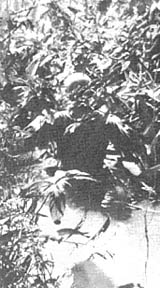 |
ELUSIVE CHARLIE - Almost lost in the foliage, a rifleman from Delta Company, 2d Battalion, 27th Infantry Wolfhounds carries on the incessant search to find, fix and finish the enemy. (PHOTO BY SP4 ROBERT O’HARE) |
Page 7 TROPIC LIGHTNING NEWS October 21, 1968
Warrior Motor Pool Keeps Them Running
DAU TIENG - The 2d Battalion, 12th Infantry operations five miles
northwest of Saigon have, for the past two months, depended on two resupply
convoys from their rear staging area at Tan Son Nhut Air Base every day.
The Third Brigade’s struggle to keep this vital supply link
functioning and to keep the battalion’s mechanical equipment in top working
condition, is being admirably handled by the White Warriors motor pool section.
The section is under the direction of Staff Sergeant Gary L. Neff from Tacoma,
Washington.
Working conditions for most Americans in Vietnam are sub-standard
compared to home. However infantry division mechanics perhaps serve as one
of the best examples of how the job can be done under the most adverse of
circumstances.
The Warrior’s canvas quonset garage covers a gravel floor where a
hand dug hole in the wet mud-clay serves as a grease rack. Army and Air
Force conex boxes are employed as tool sheds and parts storage lockers.
With fifty-six motor vehicles and gasoline powered electrical
generators demanding constant attention and feeding, the mechanics and clerks
wage what often becomes a sixteen-hour-a-day battle against the rain, mud and
dust.
Repairs and oil changes are only part of the picture. The
motor pool also maintains a clerk staff whose job is to carefully screen and
test applicants for a military driver’s license. This same staff must
also assure that the proper tools and parts are available when they are needed
in the shop.
When the 2nd Battalion, 12th Infantry White Warriors in the field
receive their hot evening meal, clean clothes, and rations of cold drinks they
owe a vote of thanks to the motor pool, a team that keeps it all coming.
|
BY SP4 CHARLES HAUGHEY |
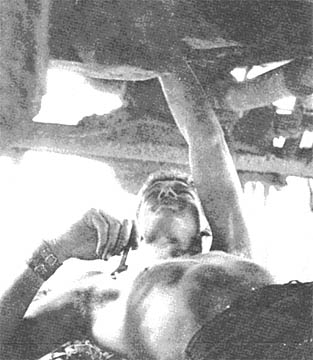 |
LYING DOWN ON THE JOB - SP4 Dan Weller from Muskegon, Michigan makes repairs on a five-ton truck. |
| MOTOR MECHANIC - SP4 Howard Rhodes from Smithfield, N.C., changes a faulty water pump on a deuce-and-a-half. |  |
 |
REPLACING BRAKES - on a deuce-and-a-half is a regular chore for SP4 Thomas Wood from Albion, Oklahoma, especially during the rainy season. |
| MOTOR POOL CLERK - PFC Noah Clayton of Anderson, Alabama, plays the important role of keeping records and keeping things in order in the maintenance shop. |  |
Page 8 TROPIC LIGHTNING NEWS October 21, 1968
 |
COLONEL Lewis J. Ashley, commander of the 3d Brigade (left), examines a cannister of fuses for enemy 82 mm mortars which were part of a giant cache of enemy rockets, mortars and ammo found in a canal several miles west of Saigon by the 2d Battalion, 12th Infantry. Captain Joe W. Rigby, Battalion executive officer, looks on. (PHOTO BY SP4 CHARLES HAUGHEY) |
NVA Attack...
Most of page 8 contained an advertisement and order form for the 1967-68 Division Yearbook
Thanks to
Paul Gargis, 3rd Bn., 22nd Inf. for sharing this issue,
Kirk Ramsey, 2nd Bn., 14th Inf. for creating this page.
This page last modified 8-12-2004
©2004 25th Infantry Division Association. All rights reserved.